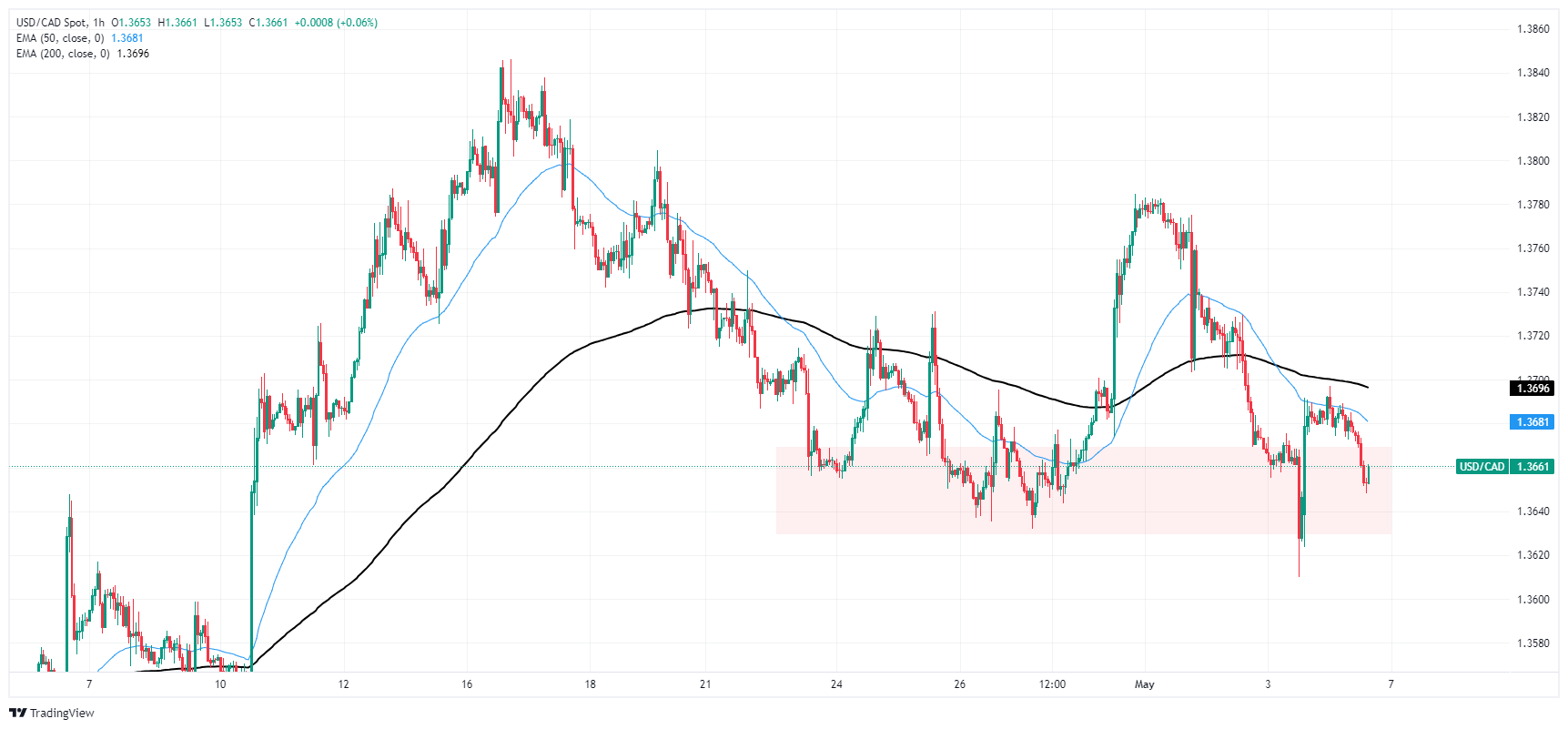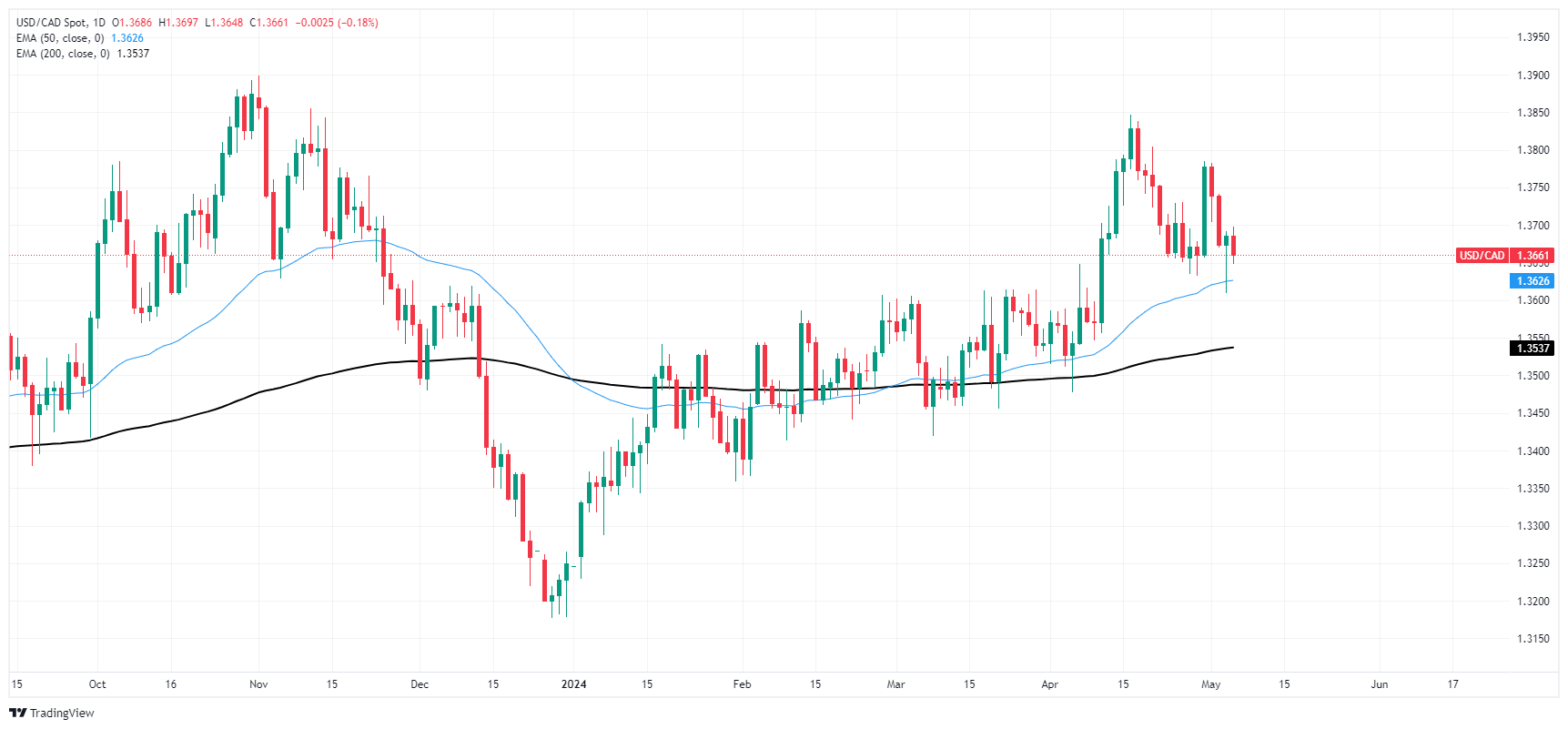- The Canadian Dollar moves higher on Monday's bounce.
- Data from Canada is thin until Friday's jobs numbers.
- Rates markets put the odds of a Fed rate cut in September at 65%.
He Canadian Dollar (CAD) is experiencing a moderate bounce on Monday, regaining ground lost late last week during the decline in risk appetite, as markets moved away from the CAD. However, markets start the new week higher, with little Canadian economic data throughout the week until Friday's jobs report.
The first CAD data of the week will be released in Canada on Tuesday, with the Ivey Purchasing Managers' Index (PMI) for the month of April. Market reaction will be muted at best with the release of mid-level data, and the rest of the week remains muted, with strictly low-level economic data coming out of Canada until Friday's rate release. Canadian unemployment and wage data for April.
Daily Market Moves Summary: Canadian Dollar Finds Some Bids on Quiet Start to Monday
- The Canadian dollar regains ground on Monday, while the CAD rebounds after Friday's sell-off.
- Tuesday's Canadian PMI (seasonally adjusted) is expected to rise to 58.1 from 57.5, a 12-month high.
- Friday's Canadian unemployment rate is expected to rise in April to 6.2% from 6.1%.
- With little significant data on the agenda this week for both the CAD and the US Dollar, the only thing left for markets is to wait for better data and reactions to the headlines.
- According to CME's FedWatch tool, rates markets are betting around a 65% chance of a cut of at least 25 basis points by the Federal Reserve (Fed) in September.
Price of the Canadian Dollar today
The following table shows the percentage variation of the Canadian Dollar (CAD) against the main currencies. The Canadian Dollar was the strongest currency against the Japanese Yen.
| USD | EUR | GBP | CAD | AUD | JPY | NZD | CHF | |
| USD | -0.20% | -0.25% | -0.23% | -0.19% | 0.21% | -0.06% | -0.05% | |
| EUR | 0.19% | -0.05% | -0.04% | -0.01% | 0.39% | 0.13% | 0.14% | |
| GBP | 0.23% | 0.06% | 0.02% | 0.06% | 0.45% | 0.19% | 0.20% | |
| CAD | 0.23% | 0.04% | -0.02% | 0.04% | 0.45% | 0.17% | 0.18% | |
| AUD | 0.19% | 0.01% | -0.06% | -0.04% | 0.40% | 0.13% | 0.15% | |
| JPY | -0.22% | -0.39% | -0.44% | -0.44% | -0.38% | -0.23% | -0.27% | |
| NZD | 0.06% | -0.13% | -0.19% | -0.17% | -0.13% | 0.28% | 0.01% | |
| CHF | 0.07% | -0.14% | -0.20% | -0.18% | -0.16% | 0.29% | -0.01% |
The heat map shows the percentage changes of the major currencies against each other. The base currency is chosen in the left column, while the quote currency is chosen in the top row. For example, if you choose the Euro in the left column and scroll down the horizontal line to the Japanese Yen, the percentage change that appears in the box will represent EUR (base)/JPY (quote).
Technical analysis: Canadian dollar retreats, USD/CAD falls into short-term supply zone
The Canadian Dollar (CAD) is advancing across the board, gaining ground against almost all major currencies on Monday. Against the US Dollar (USD), the CAD advanced almost a quarter of a percentage point and against the Japanese Yen (JPY) it gained around half a percentage point.
The USD/CAD pair has returned to familiar lows, retreating towards a known demand zone below 1.3670. The pair is in the 1.3660 area as CAD buying against the US Dollar keeps the pair pinned below the 200 hourly EMA near 1.3695.
The daily candlesticks leave USD/CAD in slightly more bullish technical form, trading north of the 200-day EMA at 1.3550. The pair is up 3.1% in 2024 but is still trading below the yearly high near 1.3850.
USD/CAD hourly chart
USD/CAD daily chart
Frequently Asked Questions about the Canadian Dollar
The key factors that determine the price of the Canadian Dollar (CAD) are the level of interest rates set by the Bank of Canada (BoC), the price of Oil, Canada's main export product, the health of its economy, the inflation and the trade balance, which is the difference between the value of Canadian exports and its imports. Other factors are market sentiment, that is, whether investors bet on riskier assets (risk-on) or look for safe havens (risk-off), with the risk-on being positive for the CAD. As Canada's largest trading partner, the health of the US economy is also a key factor influencing the Canadian dollar.
The Bank of Canada (BoC) exerts significant influence over the Canadian Dollar by setting the level of interest rates that banks can lend to each other. This influences the level of interest rates for everyone. The BoC's main objective is to keep inflation between 1% and 3% by adjusting interest rates up or down. Relatively higher interest rates are usually positive for the CAD. The Bank of Canada can also use quantitative easing and tightening to influence credit conditions, with the first being negative for the CAD and the second being positive for the CAD.
The price of oil is a key factor influencing the value of the Canadian Dollar. Oil is Canada's main export, so the price of oil tends to have an immediate impact on the value of the CAD. Generally, if the price of oil rises, the CAD also rises, as aggregate demand for the currency increases. The opposite occurs if the price of oil falls. Higher oil prices also tend to lead to a higher probability of a positive trade balance, which is also supportive for the CAD.
Although inflation has traditionally always been considered a negative factor for a currency, since it reduces the value of money, the truth is that in modern times the opposite has happened with the relaxation of cross-border capital controls. Inflation tends to lead central banks to raise interest rates, which attracts more capital from investors around the world looking for a lucrative place to store their money. This increases the demand for the local currency, which in the case of Canada is the Canadian Dollar.
The macroeconomic data that is released measures the health of the economy and can influence the Canadian dollar. Indicators such as GDP, manufacturing and services PMIs, employment and consumer sentiment surveys can influence the direction of the CAD. A strong economy is good for the Canadian dollar. Not only does it attract more foreign investment, it may encourage the Bank of Canada to raise interest rates, resulting in a stronger currency. However, if economic data is weak, the CAD is likely to fall.
Source: Fx Street
I am Joshua Winder, a senior-level journalist and editor at World Stock Market. I specialize in covering news related to the stock market and economic trends. With more than 8 years of experience in this field, I have become an expert in financial reporting.







